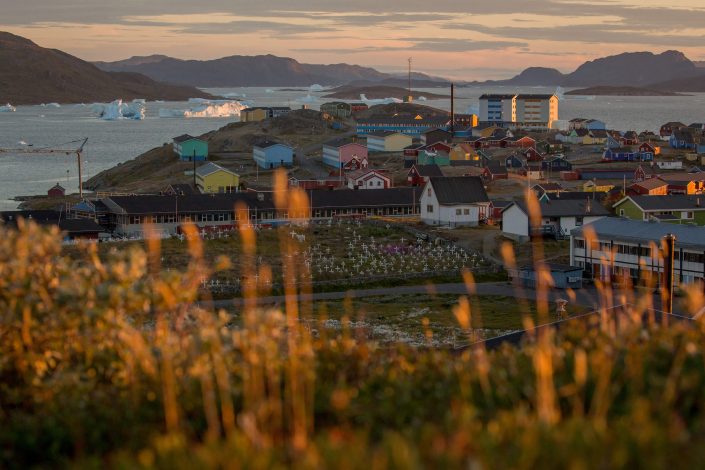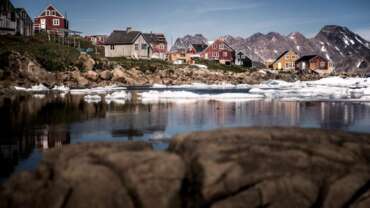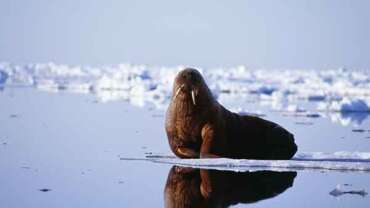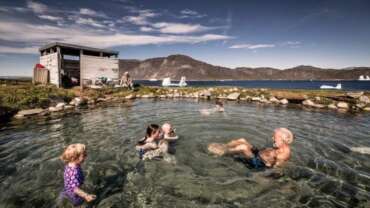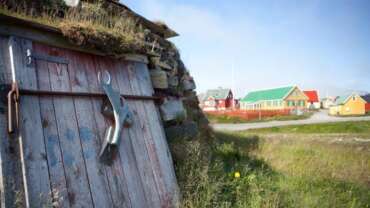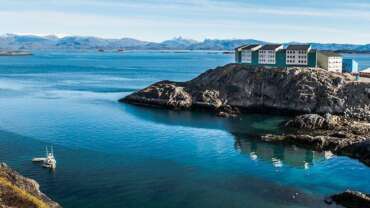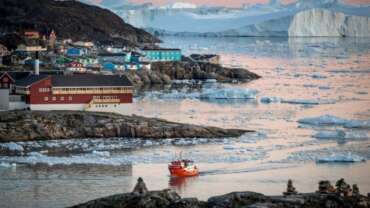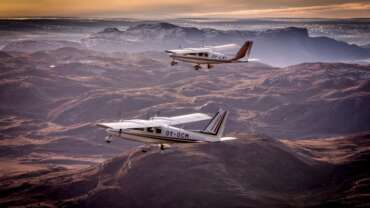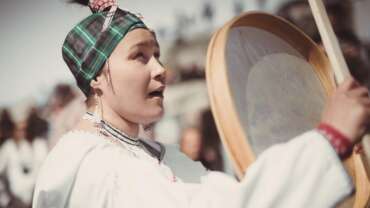South Greenland
Destination South Greenland is a land of jagged mountains and green pastures where sheep farms directly border ice fjords, and Norse settlement history intersects with modern Greenlandic fishing and hunting communities. Fresh vegetables, natural hot springs on a remote island, big wall climbing, and fjord kayaking abound in South Greenland.
Dirt roads and hiking trails between farming communities, and a great band of sea ice flowing straight down from the northern seas are all unique South Greenlandic elements.
All this is tied together by a distinct South Greenlandic culture with strong ties to the history of the North Atlantic and a sense of sharing stories and welcoming guests.
The southernmost part of Greenland lives up to its name, Greenland. The “garden of Greenland” offers a contrasting and fertile climate, unique history, cities with exciting cultural offerings and cozy settlements.
NANORTALIK
Vertical walls and pristine waters in Tasermiut Fjord make an adventurer’s imagination run wild while city sightseeing bring you down to earth.
UNIQUE IN SOUTH GREENLAND
Nanortalik stands on an island, literally and figuratively. Though it sits deep in South Greenland, whose reputation is as an idyllic paradise with fields of colorful flowers, Nanortalik breaks the mold. Its vertical walls that flank an intricate fjord system hint at a nature more akin to Greenland’s east coast. Add to that the expanse of sea ice just outside the harbor and the cultural migration of East Greenlanders to Nanortalik’s villages, and what you find is that Nanortalik is quite unique for South Greenland.
Like most islands, the journey to Nanortalik is involved, but the welcoming and friendly atmosphere that awaits you in town is worth the trip. As we Greenlanders say, once you have reached Nanortalik, it’s like returning to your childhood home. Come to Nanortalik to explore wild mountains and find the hometown you never knew you had.
STRONG NATURE IN NANORTALIK
From sea to mountain top, Nanortalik is surrounded by powerful nature. To the east stand many ranges of daunting peaks that seem to pierce the sky, and to the west float enormous sheets of sea ice with a collection of Arctic wildlife in tow.
The possibilities to experience nature in Nanortalik are as many as your imagination can handle. For the day hiker, just step out your front door and find the path that leads to panoramic views of Nanortalik from a southern vantage point. Later, challenge your sea legs by taking a boat trip along the Nanortalik coastline spotted with islands.
Did you notice that white line radiating from the horizon? It is not your ordinary icebergs but rather the great sea ice that forms from frozen ocean water and migrates from East Greenland in spring.
- Nanortalik is the southernmost town in Greenland, located on an island also called Nanortalik, at the mouth of Tasermiut Fjord.
- Nanortalik was founded in 1797. It currently has approximately 1350 inhabitants, making it the 10th largest town in Greenland.
- Five villages and several sheep farms surround Nanortalik.
- Nanortalik means “the place with polar bears”, as polar bears live and hunt on the sea ice outside of town.
- Vertical cliffs and steep peaks characterize the Nanortalik nature. Ketil Mountain is 2000 meters tall and has one of the world’s highest climbing walls.
- Tasermiut South Greenland Expeditions is a trusted outfitter for expeditions in Nanortalik.
- Greenland’s only natural forest exists 40 km from Nanortalik, in Qinngua Valley. There, trees grow to be several meters tall.
- Cruise ships from North America and Europe dock in Nanortalik throughout the summer.
TASERMIUT FJORD
For those craving the inevitable next adrenaline rush, the search stops with Tasermiut Fjord. The juxtaposition of harsh rock rising straight out of reflective fjord waters is extreme and mesmerizing.
Defy gravity on some of the most challenging rock climbing lines in Greenland, or put your paddle to the test against the electrifying Arctic current right beneath your kayak. After an expedition into Tasermiut Fjord, you can go home a decorated adventurer.
CHOIR CULTURE
With true Greenlandic character, Nanortalik locals are charming and friendly. Whether you meet casually around town or over a feast of traditional Greenland gastronomy, Greenlanders are keen to lend a helping hand or extend an invitation to a choir performance. Choir singing is identifiably synonymous with Nanortalik, and thanks to a handful of groups in town, you have ample opportunity to experience this exclusive Nanortalik tradition.
The Nanortalik Museum pays homage to the colonial era and Old Norse culture, answering most questions about the town and its beginnings as a commercial spot. But one question remains in the air – how did a natural rock near to the church come to have an uncanny affinity to the great polar explorer, Knud Rasmussen? Perhaps when you visit Nanortalik you can uncover the story behind the stone.
QAQORTOQ
The largest town in South Greenland gives you art, culture, Norse history, boat tours, hot springs, kayaking and hiking trips.
IS THERE A RIVIERA IN GREENLAND?
Qaqortoq rises quite steeply over the fjord system around the city, and on hot summer days you may be tricked into thinking that there is a sub-arctic Riviera, a special Greenlandic version with icebergs in the bay and frolicking whales in the fjord, instead of sandy beaches, palm trees and over-population.
Qaqortoq is best seen on foot, which does say something about the size of our towns considering Qaqortoq is the largest in Southern Greenland.
Several tours to nearby hill tops open up a view to the surrounding mountain areas and to the pack ice at sea, drifting down the east coast of Greenland towards the Atlantic Ocean. The hike around the water supply, Lake Tasersuaq, will take you from the center of the city out into the mountains in a matter of minutes, and if you really wish to explore the city’s backcountry, the five-day hike to the Norsemen’s old Episcopal residence and the sheep farming settlement of Igaliku, is an obvious choice.
ADVENTURES IN THE WILDERNESS AROUND QAQORTOQ
Qaqortoq is well-connected with the surrounding South Greenlandic landscape that is full of adventure opportunities, and especially, when out on a boat the region really seems to open up.
The fjords around the city are popular kayaking destinations, small passenger boats will take you to the church ruin at Hvalsey, to Narsaq, to Igaliku and to the hot springs at Uunartoq.
We only recommend the trip to the hot springs if you are strong-willed, because once you experience the 38 degree Celsius warm water in this bathtub made by nature, you will find it very difficult to see why one should be doing anything else in life.
- Qaqortoq is the largest city in Southern Greenland with 3.229 inhabitants.
- The city was founded in 1775.
- Qaqortoq is an educational city with a high school, and the city is the center of commerce and trade in Southern Greenland.
- Qaqortoq is the only city in Greenland with a fountain in the center square.
- Local tour organizers will gladly assist in organizing tours to the hot springs in Unnartoq, the church ruins at Hvalsey, and to the surrounding towns and settlements.
- Qaqortoq is a popular cruise destination for the large ships crossing the Atlantic.
- The city has two large grocery stores and several smaller convenience stores.
- The city has a hotel, two youth hostels and accommodation in rental houses.
CULTURAL EXPERIENCES IN QAQORTOQ
During the mid-1990s, the Greenlandic artist, Aka Høegh, launched an ambitious sculpture project with artists from all of the Nordic countries. The following result was the exhibition Stone & Man, forty sculptures carved all around the city, many of them carved right out of the surrounding rock face. When we call something here a permanent exhibition, we really mean it!
Qaqortoq Museum is in possession of a collection of quite odd looking tupilaks or talismans, carved by the masters, Aron and Cecilie Kleist. The collection is the focal point of a museum which has the interesting habit of mixing modern art with classical Greenlandic cultural expressions.
The museum is located right next to the central square in Qaqortoq, or plaza if we are to keep our comparison with the Riviera, and even if it is not the Trevi fountain we are able to show off, nevertheless, the soon to be hundred-year-old fountain which is a well known and much loved destination for an excursion. Around the fountain is the old Qaqortoq city core, with historical buildings, cafe, eateries and even a stream running straight through the center of the old area.
URBAN YOUTH IN A MODERN GREENLANDIC CITY
While the classic cultural elements are an obvious choice for many visitors to Qaqortoq when exploring the city, especially pertaining to Norse history, artistic life and food culture, it is worth noticing that Qaqortoq is also large enough to have a vibrant youth culture.
The city’s high school brings young people together. Young Greenlanders often use the light summer nights to meet in a forum. It may be far from the large cities of the world, but to them it is a very urban setting with street sports and games and hip expressions.
NARSAQ
Narsaq is the most striking agricultural town in Greenland situated in a fjord system known for hiking, mineral deposits and cowboy history.
MUSSE, MCCARTNEY AND NARSAQ’S COWBOYS
Although it may sound that way, Musse and McCartney are not country and western singers from the USA. They are just names given to a couple of the many horses, and like in any western town in the USA would, in the old days, be tied up out in front of the homes in Narsaq, when they were not used for sheep herding or transportation over the mountain.
Although the number of horses is not what it used to be in this most striking agricultural town in Greenland, many of the inhabitants identify to such a degree with sheep farming, cattle ranching and agriculture that they jokingly refer to themselves as cowboys.
With the passing of time, many of the sheep farmers have moved away from the town, but you can still see a number of lush, fenced gardens, a testament to the protection given to the sheep who would roam freely around in the streets. The gardens are the breadbaskets of the town, supplying the local population with potatoes, turnips, carrots, lettuce and strawberries in sizeable quantities.
KITCHEN GARDENS AND THE NORSEMEN OF NARSAQ
One day during the 1960’s, the desire to dig out some fresh dirt for a kitchen garden accidentally unearthed a Norse ruin right in the middle of town where the sheep were grazing next to the factory and the slaughter house. The manager of the factory found much more than a little dirt – Norse artifacts appeared with each shovelful, and before long, archeologists had unearthed a complete long house in the middle of town.
This long house is believed to be the very first place Eric the Red settled before moving to Brattalid at the end of the Tunulliarfik Fjord, where the settlement Qassiarsuk is located today. So it was in Narsaq in 1982, that that official celebrations commemorating the 1000th anniversary of the Norsemen’s arrival in Greenland took place.
- It is the youngest town in Greenland, founded as late as in 1959.
- Local boat operators handle passenger transportation to places like Qassiarsuk, Narsasuaq, Qaqortoq and to Itilleq by Igaliku.
- Arctic Umiaq Line’s passenger ship makes a stop in Narsaq on the ships route which connects the southern part of Greenland with the West Coast all the way up to Ilulissat.
- The mountain known as Qaqqarsuaq behind the town contains coveted minerals and attracts many rock pickers and others who have an interest in geology.
- The history of the Norsemen is on display at the museum, and a local rock picker has created his own exhibit about minerals and rocks, including the rare mineral, Tugtupit which so far has only been found in very few places worldwide.
HIKING AND MINERAL DEPOSITS
It is a combination of agriculture, Norse history and the landscape around Narsaq which provides the experience with a special South Greenlandic flavour.
Hiking in the mountains and valley behind the town opens up the countryside towards the backcountry. For persistent hikers the trek over the mountain to Qassiarsuk is a typical journey through the South Greenlandic countryside with sheep farms, green river valleys, raw mountains and ice-filled fjords.
If you are interested in some of the many mineral deposits in Greenland, then you may be familiar with the Dyrnæs-Narsaq complex. For those who may not have considered this to be a part of their South Greenland experience, the concentration of granite, sandstone, lavas and Tugtupit – a rare, semi precious stone which changes color – are all reminders of the mountain treasures in this part of the country.
CLOSE TO NATURE IN NARSAQ
In Narsaq you will notice that local people appreciate closeness with nature and consider it as one of the town’s core values. Hunting grounds are within hiking distance of the town, which is unusual in South and West Greenland, and the rivers ripe for fishing are likewise just a stone’s throw – or should we say a fly’s cast – away.
During May, there is an exodus of local people to one specific river where everyone aims to catch the first Arctic char of the season, in an event that is reminiscent of harvesting the first potatoes or opening the season’s first bottle of Beaujolais in other parts of the world.
The Arctic char is sold at very high prices at the local market and it is typically Greenlandic that events like these have far greater local importance than the fact that the well-known Danish author, Jørn Riel, once lived in the town and that his house is still there.
IGALIKU
Igaliku is a versatile, family-oriented, open-air destination with Norse ruins, modern agriculture, sheep farms, and many hiking opportunities.
A SETTLEMENT FULL OF PERSONALITIES
For some reason the settlement Igaliku attracts people known for their strong personalities. Either they founded an Episcopal residence, like the Norsemen did on the farm Gardar in 1124, or they decided to move to the area and re-found it centuries after it was last abandoned, like the Norwegian man Anders Olsen and his Greenlandic wife, Tuperna, did in 1783.
According to anecdotes, actress and singer Marlene Dietrich also visited Igaliku during World War II, when she was staying at the nearby American airbase at Narsarsuaq, entertaining the troops. Today the little sheep farming settlement has just 27 residents who stay all year. The well-known Greenlandic artist, Aka Høegh, has a summer cabin in Igaliku and the settlement is also home to Christian Egede, who often can be found sitting outside his house entertaining with his accordion.
You will probably understand why Igaliku draws so many people when you, for the very first time, hike over the road called Kongevejen from the marina at Itilleq, or when you arrive through the fjord by boat from Qaqortoq.
The oldest sheep farming settlement in Greenland boasts tall mountains with peaks covered by snow during summer, rolling valleys lush with flowers, sheep and tall grass. A collection of sandstone houses, so different from the very distinctive wooden houses in Greenland, draw a portrait of a settlement with an ancient history, and a dynamic modern day narrative.
- Igaliku, “The Place Like a Pot”, was founded in 1782 by the Norwegian merchant, Anders Olsen and his Greenlandic wife, Tuperna.
- The settlement is also known as Gardar, after the Episcopal residence built by the Norsemen around 1100 A.D.
- Today Igaliku is a sheep farming settlement with 27 inhabitants.
- The Igaliko Country Hotel offers rooms and cabins.
- The Hotel serves food and runs the Igaliku cafe.
- Gardar Hostel offers accommodation in typical youth hostel style.
- The local grocery store run by Pilersuisoq offers basic household staples.
AN OPEN-AIR DESTINATION WITH A LOT OF ADMIRERS
Igaliku is a family-oriented open-air destination, with short and long hiking trails, kayak rentals, farm visits, and cultural experiences around the ruins of the old Episcopal residence and the one thousand year old irrigation system, which is partly still in use today.
The settlement receives a lot of visitors during early August, when Anders Olsen’s decedents arrive, to meet for a weekend of festivities, to celebrate the birthday of the settlement’s founding father. The event is well worth a visit if you can find somewhere to sleep, and get a ride on a boat from one of the many Greenlanders going to the settlement during that time.
HIKING TRAILS AROUND IGALIKU
You don’t need to go to Igaliku by boat if you prefer to hike there, as there is a well-marked five-day hiking trail over the mountain from Qaqortoq. On the trail you will have an opportunity to hike the hill, Redekammen, and to swing by the old well-kept church ruin at Hvalsey, one of the best known Norse landmarks in Greenland.
Going on the trail towards the north from Igaliku the main draw is the icefjord called Qooroq, worth a day’s hike for some, while others prefer instead to “greet” the sheep on the hill behind the settlement or hang out at the small hotel, where there is always time for a cup of coffee on the terrace.
NARSARSUAQ
Narsarsuaq is the gateway to hiking trails through lush valleys and Norse ruins spotted along a deep fjord.
A HISTORIC FJORD
Narsarsuaq and its immediate surroundings in Tunulliarfik Fjord hold incredible significance to Greenland’s history, for the land where Narsarsuaq now stands earned Greenland its name. The Norse Vikings settled in this vicinity many centuries ago and gave Narsarsuaq a name that hints that an Arctic forest covered the large plain. Taking tales of verdant nature in a deep fjord home to their Nordic brethren, the Vikings called this country Greenland. With Narsarsuaq as your home base, uncover the long history that lies in Tunulliarfik Fjord. Connect the dots of Viking ruins by sailing or hiking between Qassiarsuk, Igaliku, and Hvalsey. It is one thing to read about medieval farms in the sagas but quite another to see them come alive by standing in the same spots where Erik the Red and Viking settlers stood over a millennium ago.
OUTDOORSMAN’S PARADISE
Excitement fills you as you arrive to Narsarsuaq, but how can such a small village instill so much adrenaline and anticipation, you wonder? The mighty nature that surrounds Narsarsuaq – the fjord waters spotted with turquoise icebergs and the deep valley that points directly toward the Greenland Ice Sheet – just waits to be explored. While this beauty summons you into the nature like a great force, it is the solitude and the contrast of idyllic valleys next to powerful and rugged ice that keep you there.
Sailing amongst blue ice or hiking and flying around lush hills and glaciers are the classic experiences that add great action to your holiday. But a true outdoorsman can also find happiness in the small delights around Narsarsuaq. Go fishing on the beach and ride bikes along grassy pathways to find relics from when Narsarsuaq was an American military base. Or count eagles and hawks overhead as you pick the most beautiful napping spot in the Valley of Flowers.
- Narsarsuaq is the gateway to South Greenland. Its name means “the large plain”, after its natural surroundings.
- Narsarsuaq is located 100 km inside Tunulliarfik Fjord, just 6 km from the Greenland Ice Sheet.
- Narsarsuaq has 160 residents.
- Norse ruins from the 10th-15th centuries spot the hills around Narsarsuaq, including Brattahlid, the settlement of Erik the Red, where the first Christian church in all of North America was erected.
- Narsarsuaq is a popular cruise destination welcoming vessels from North America and Europe.
- The only beekeeper in Greenland lives in Narsarsuaq and sells small jars of honey in souvenir shops.
- Narsarsuaq was founded as an American airbase in 1941 called “Blue West 1”. The “Hospital Valley” pays homage to this era.
- Narsarsuaq Airport has the second-longest runway in Greenland, allowing it to accept larger airplanes. International flights arrive from Denmark and Iceland, and domestic flights arrive from Kangerlussuaq, Nuuk, and Paamiut.
SMALL VILLAGE; INTERNATIONAL MENTALITY
The residents of Narsarsuaq are a small yet close-knit band of dedicated people who think far beyond the boundaries of their South Greenland village. Nearly everyone in the village plays a vital role to ensuring Narsarsuaq is welcoming for international guests, tending to everything from the airport and cruise harbor to the hotels, cafés, and shops. At the height of the summer, Narsarsuaq has quite a global atmosphere as it houses travelers from all over the world who often outnumber even the Greenlanders!
QASSIARSUK
The settlement is an agricultural destination for hikers and a visible meeting place between Norse culture and modern-day sheep farmers.
A THOUSAND YEARS OF SHEEP FARMING AND AGRICULTURE
One thousand years ago a group of Norsemen, with Eric the Red in the front, sailed into the bay where the settlement Qassiarsuk is located today. According to legend, Eric had such strong emotional ties to the area where he had grown up in Norway that he baptised the place he found, Brattahlíð which means “steep hill”. Before long, he and his companions had established an agricultural community in the fjord.
Farming is still the main occupation in Qassiarsuk and the sheep farmers in the area cultivate the same fields, and let their animals graze in the same river valleys and the same hillsides that the Norsemen used towards the end of the 9th century.
The agriculture of the sheep farms is also about a special feeling of community, and you will experience the strong bonds and the close cooperation between the families living in the settlement and the farms in the countryside.
REMOTE FARMS WITH MODERN CONNECTIONS
Where the gravel roads end around the settlement lie the sheep farms that give new meaning to the word “remote”, and especially in Tasiusaq and Nunataaq, about a day’s hike west of Qassiarsuk, the fields reach down to the edge of the water, in fjords where icebergs from the Ice Cap drift by on their way towards the ocean.
Yet, you will experience that the locals are connected to the internet, watch satellite television and run modern farms adapted for export, send their kids to a well-run school in the settlement and are generally focused on seeing the next generation grow up and get educated, even if this means that the young will have to leave South Greenland for a number of years.
- Qassiarsuk is a sheep farming settlement founded in 1924 by Otto Frederiksen. Many of his descendants today are among the settlements 50 inhabitants.
- Eric the Red and his wife Thorhildur settled here in 982 and built the first Christian church on the North American continent.
- Today Qassiarsuk has a grocery store and a cafe.
- There is a 120 kilometer gravel road in Qassiarsuk and the surounding hillsides and the area is great for hiking trips.
- Due to the sheep in the settlement the surrounding area has no mosquitoes.
- Every year Qassiarsuk hosts the Leif Ericsson Marathon.
THE NORSEMEN IN QASSIARSUK
Qassiarsuk was the stronghold of the Norsemen. It was here they built the first Christian church on the North American continent, and it was from this location that their culture of farming spread to the rest of South Greenland.
Today a statue of Leif Ericsson has been erected on a prominent vantage point in Qassiarsuk keeping watch over both the past and the present. In the Danish language, Leif is better known by his nick names – Leif the Happy, Leif the Lucky, or simply Eric the Red’s son. He is the very first man to sail towards the west arriving in North America at a place he called, Vinland. A feat of that magnitude is not left unnoticed in South Greenland.
Qassiarsuk is the most important of all the Norsemen landmarks in South Greenland because the ruins are still very much part of the present-day landscape, and with the re-construction of Thodhilde’s Christian church and the adjacent long house, you will experience the feel of these historical buildings coming alive in a way that is unique in Greenland.
HIKING AND THE WILDERNESS EXPERIENCE IN QASSIARSUK
Although the actual growth of trees is limited to certain protected fjords, the landscape of South Greenland nevertheless in many ways resembles the fjords of western Norway.
The area around Qassiarsuk has mountain hiking trails as well as a 100 kilometer gravel road that connects the settlement with the surrounding farms of Tasiusaq, Nunataaq, Sillisit, Qorlortoq and Ipiutaq that offer accommodation if you wish to stay overnight on the route.
One of the classic treks in Greenland is the 60 kilometer hike from Qassiarsuk over the mountain to Narsaq. The route changes between easy-to-walk gravel roads, staying overnight at a sheep farm, and trekking over a mountain area with many remnants of the Norsemen.



